dsp.FIRFilter
Static or time-varying FIR filter
Description
The dsp.FIRFilter
System object™ filters each channel of the input using static or time-varying FIR filter
implementations.
To filter each channel of the input:
Create the
dsp.FIRFilterobject and set its properties.Call the object with arguments, as if it were a function.
To learn more about how System objects work, see What Are System Objects?
This object supports C/C++ code generation and SIMD code generation under certain conditions. For more information, see Code Generation.
Creation
Description
fir = dsp.FIRFilterfir, which independently filters each
channel of the input over time using a specified FIR filter implementation.
fir = dsp.FIRFilter(num)fir, with the Numerator property
set to num.
fir = dsp.FIRFilter(Name=Value)InitialConditions to 3.
Properties
Unless otherwise indicated, properties are nontunable, which means you cannot change their
values after calling the object. Objects lock when you call them, and the
release function unlocks them.
If a property is tunable, you can change its value at any time.
For more information on changing property values, see System Design in MATLAB Using System Objects.
Specify the filter structure. You can specify the filter
structure as one of "Direct form",
"Direct form symmetric", "Direct form
antisymmetric", "Direct form
transposed", or "Lattice MA".
Specify the source of the filter coefficients as
"Property" or "Input port".
When you specify "Input port", the filter object
updates the time-varying filter once every frame.
Dependencies
This applies when you set the Structure
to "Direct form", "Direct form
symmetric", "Direct form
antisymmetric", or "Direct form
transposed".
Specify the source of the Lattice filter coefficients as
"Property" or "Input port".
When you specify "Input port", the filter object
updates the time-varying filter once every frame.
Dependencies
This applies when you set the Structure
to "Lattice MA".
Specify the filter coefficients as a real or complex numeric row vector.
Tunable: Yes
Dependencies
This property applies when you set the
NumeratorSource property to
"Property", and the Structure property is set to
"Direct form", "Direct form
symmetric", "Direct form
antisymmetric", or "Direct form
transposed".
Data Types: single | double | int8 | int16 | int32 | int64 | uint8 | uint16 | uint32 | uint64
Complex Number Support: Yes
Specify the reflection coefficients of a lattice filter as a real or complex numeric row vector.
Tunable: Yes
Dependencies
This property applies when you set the Structure property to
"Lattice MA", and the
ReflectionCoefficientsSource property to
"Property".
Data Types: single | double | int8 | int16 | int32 | int64 | uint8 | uint16 | uint32 | uint64
Complex Number Support: Yes
Specify the initial conditions of the filter states. The number of states or delay elements equals the number of reflection coefficients for the lattice structure, or the number of filter coefficients–1 for the other direct form structures.
You can specify the initial conditions as a scalar, vector, or matrix. If you specify a scalar value, the FIR filter object initializes all delay elements in the filter to that value. If you specify a vector whose length equals the number of delay elements in the filter, each vector element specifies a unique initial condition for the corresponding delay element. The object applies the same vector of initial conditions to each channel of the input signal.
If you specify a vector whose length equals the product of the number of input channels and the number of delay elements in the filter, each element specifies a unique initial condition for the corresponding delay element in the corresponding channel.
If you specify a matrix with the same number of rows as the number of delay elements in the filter, and one column for each channel of the input signal, each element specifies a unique initial condition for the corresponding delay element in the corresponding channel.
Tunable: Yes
Data Types: single | double | int8 | int16 | int32 | int64 | uint8 | uint16 | uint32 | uint64
Fixed-Point Properties
Specify whether to use full precision rules. If you set
FullPrecisionOverride to
true, which is the default, the object
computes all internal arithmetic and output data types using full
precision rules. These rules provide the most accurate fixed-point
numerics. It also turns off the display of other fixed-point
properties because they do not apply individually. These rules
guarantee that no quantization occurs within the object. Bits are
added, as needed, to ensure that no roundoff or overflow occurs.
If you set FullPrecisionOverride to
false, fixed-point data types are controlled
through individual fixed-point property settings. For more
information, see Full Precision for Fixed-Point System Objects.
Specify the rounding method.
Dependencies
This property applies only if the object is not in full precision mode.
Specify the overflow action as "Wrap" or
"Saturate".
Dependencies
This property applies only if the object is not in full precision mode.
Specify the coefficients fixed-point data type as
"Same word length as input" or
"Custom".
Dependencies
This property applies when you set the
NumeratorSource property to
"Property".
Specify the coefficients fixed-point type as a signed or unsigned numerictype (Fixed-Point Designer) object.
Dependencies
This property applies when you set the
CoefficientsDataType property to
"Custom".
Specify the reflection coefficients fixed-point data type as
"Same word length as input" or
"Custom".
Dependencies
This property applies when you set the
ReflectionCoefficientsSource property to
"Property".
Specify the reflection coefficients fixed-point type as a signed or unsigned
numerictype (Fixed-Point Designer) object.
Dependencies
This property applies when you set the
ReflectionCoefficientsDataType property
to "Custom".
Specify the product fixed-point data type as "Full
precision", "Same as input", or
"Custom".
Specify the product fixed-point type as a signed or unsigned scaled numerictype (Fixed-Point Designer) object.
Dependencies
This property applies when you set the
ProductDataType property to
"Custom".
Specify the accumulator fixed-point data type to
"Full precision", "Same as
input", "Same as product", or
"Custom".
Specify the accumulator fixed-point type as a signed or unsigned scaled numerictype (Fixed-Point Designer) object.
Dependencies
This property applies when you set the
AccumulatorDataType property to
"Custom".
Specify the state fixed-point data type as one of
"Same as input", "Same as
accumulator", or "Custom".
Dependencies
This property does not apply to any of the direct form or direct form I filter structures.
Specify the state fixed-point type as a signed or unsigned scaled numerictype (Fixed-Point Designer) object.
Dependencies
This property applies when you set the
StateDataType property to
"Custom".
Specify the output fixed-point data type as one of
"Same as input", "Same as
accumulator", or "Custom".
Specify the output fixed-point type as a signed or unsigned scaled numerictype (Fixed-Point Designer) object.
Dependencies
This property applies when you set the OutputDataType property to
Custom.
Usage
Description
Input Arguments
Data input, specified as a vector or a matrix. When the input
data is of a fixed-point type, it must be signed when the
structure is set to "Direct form symmetric" or
"Direct form antisymmetric". The FIR filter
object operates on each channel of the input signal independently
over successive calls to the object.
This System object supports variable-size input.
Data Types: single | double | int8 | int16 | int32 | uint8 | uint16 | uint32 | fi
Complex Number Support: Yes
Time-varying filter coefficients, specified as a row vector. The data and coefficient inputs must have the same data type.
Data Types: single | double | int8 | int16 | int32 | uint8 | uint16 | uint32 | fi
Complex Number Support: Yes
Output Arguments
Filtered output, returned as a vector or a matrix. The output has the same size as
the input. For single and double inputs, the
output data type matches the input data type. For integer and fixed-point inputs, the
output data type depends on the setting of the
FullPrecisionOverride and OutputDataType
properties.
Data Types: single | double | int8 | int16 | int32 | uint8 | uint16 | uint32 | fi
Complex Number Support: Yes
Object Functions
To use an object function, specify the
System object as the first input argument. For
example, to release system resources of a System object named obj, use
this syntax:
release(obj)
freqz | Frequency response of discrete-time filter System object |
filterAnalyzer | Analyze filters with Filter Analyzer app |
impz | Impulse response of discrete-time filter System object |
info | Information about filter System object |
coeffs | Returns the filter System object coefficients in a structure |
cost | Estimate cost of implementing filter System object |
grpdelay | Group delay response of discrete-time filter System object |
outputDelay | Determine output delay of single-rate or multirate filter |
Examples
Use an FIR filter to apply a lowpass filter to a waveform with two sinusoidal components.
t = (0:1000)'/8e3; xin = sin(2*pi*0.3e3*t)+sin(2*pi*3e3*t); sr = dsp.SignalSource; sr.Signal = xin; sink = dsp.SignalSink; fir = dsp.FIRFilter(designLowpassFIR(FilterOrder=10,CutoffFrequency=0.5)); sa = spectrumAnalyzer(... SampleRate=8e3,... Method="welch",... PlotAsTwoSidedSpectrum=false,... OverlapPercent=80,... SpectrumUnits="dBW",... YLimits=[-150 -10]); while ~isDone(sr) input = sr(); filteredOutput = fir(input); sink(filteredOutput); sa(filteredOutput) end

filteredResult = sink.Buffer; filterAnalyzer(fir,SampleRates=8000)
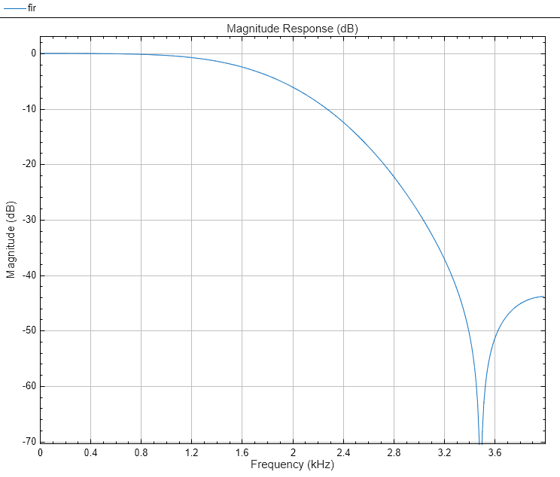
Design an FIR filter as a System object.
N = 10; Fc = 0.4; firFiltObj = designLowpassFIR(FilterOrder=N,CutoffFrequency=Fc,SystemObject=true)
firFiltObj =
dsp.FIRFilter with properties:
Structure: 'Direct form'
NumeratorSource: 'Property'
Numerator: [-1.2414e-18 -0.0126 -0.0247 0.0635 0.2748 0.3981 0.2748 0.0635 -0.0247 -0.0126 -1.2414e-18]
InitialConditions: 0
Show all properties
filterAnalyzer(firFiltObj)
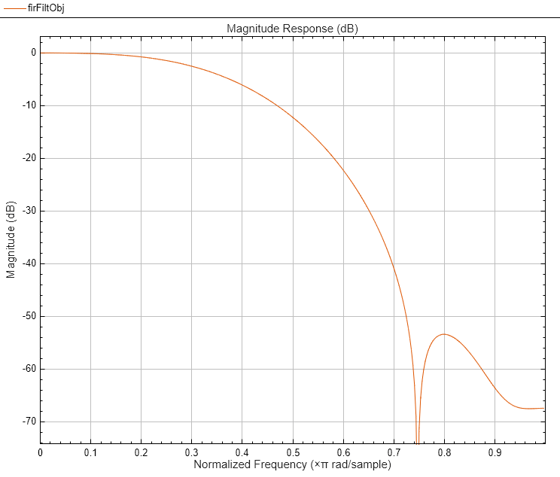
Create a dsp.FIRFilter object, and set the NumeratorSource property to "Input port" so that you can vary the coefficients of the FIR filter through the input port during simulation.
firFilt = dsp.FIRFilter(NumeratorSource="Input port")firFilt =
dsp.FIRFilter with properties:
Structure: 'Direct form'
NumeratorSource: 'Input port'
InitialConditions: 0
Show all properties
Create a spectrumAnalyzer object to visualize the spectra of the input and output signals.
spectrumScope = spectrumAnalyzer(SampleRate=44100,PlotAsTwoSidedSpectrum=false,... ChannelNames=["Input Signal","Filtered Signal"]);
Create a dsp.DynamicFilterVisualizer object to visualize the magnitude response of the varying filter.
filterViz = dsp.DynamicFilterVisualizer(NormalizedFrequency=true);
Stream in random data and filter the signal using the dsp.FIRFilter object. Use the designLowpassFIR function to design the filter coefficients. By default, this function returns a vector of FIR filter coefficients. Assign these coefficients to the dsp.FIRFilter object.
Vary the cutoff frequency of the filter during simulation. The designLowpassFIR function redesigns the coefficients based on the updated filter specifications. Pass these updated coefficients to the FIR filter. Visualize the spectra of the input and filtered signals using the spectrum analyzer.
Fcut = 0.5; for idx = 1:500 num = designLowpassFIR(FilterOrder=30,CutoffFrequency=Fcut,Window="hann"); x = randn(1024,1); y = firFilt(x,num); spectrumScope(x,y); filterViz(num,1); Fcut = Fcut + 0.0005; end
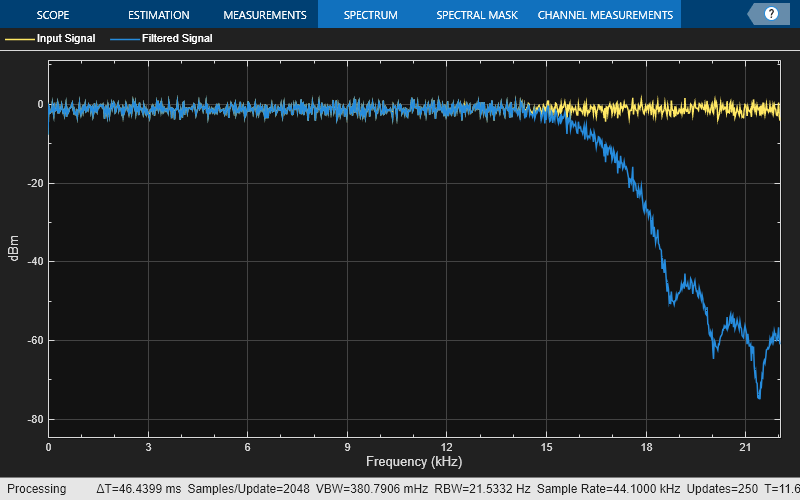
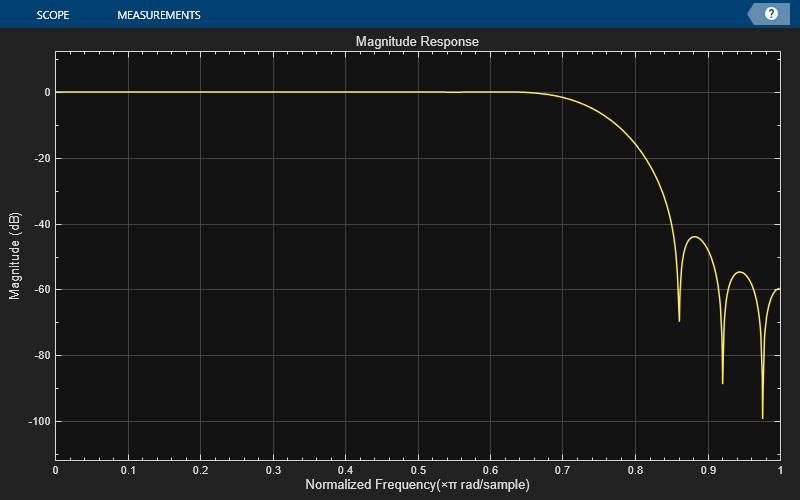
Design and implement a lowpass FIR filter object using the designLowpassFIR function. The function returns a dsp.FIRFilter object when you set the SystemObject argument to true. To design the filter in single-precision, use the Datatype or like argument. Alternatively, you can specify any of the numerical arguments in single-precision.
firFilt = designLowpassFIR(FilterOrder=30,CutoffFrequency=0.5,Window="hann",... Datatype="single",SystemObject=true)
firFilt =
dsp.FIRFilter with properties:
Structure: 'Direct form'
NumeratorSource: 'Property'
Numerator: [0 2.1297e-19 0.0011 -1.8613e-18 -0.0048 4.8729e-18 0.0122 -8.7270e-18 -0.0251 1.2757e-17 0.0477 -1.6267e-17 -0.0960 1.8649e-17 0.3148 0.5000 0.3148 1.8649e-17 -0.0960 -1.6267e-17 0.0477 1.2757e-17 -0.0251 … ] (1×31 single)
InitialConditions: 0
Show all properties
Create a dsp.DynamicFilterVisualizer object to visualize the magnitude response of the filter.
filterViz = dsp.DynamicFilterVisualizer(NormalizedFrequency=true); filterViz(firFilt)
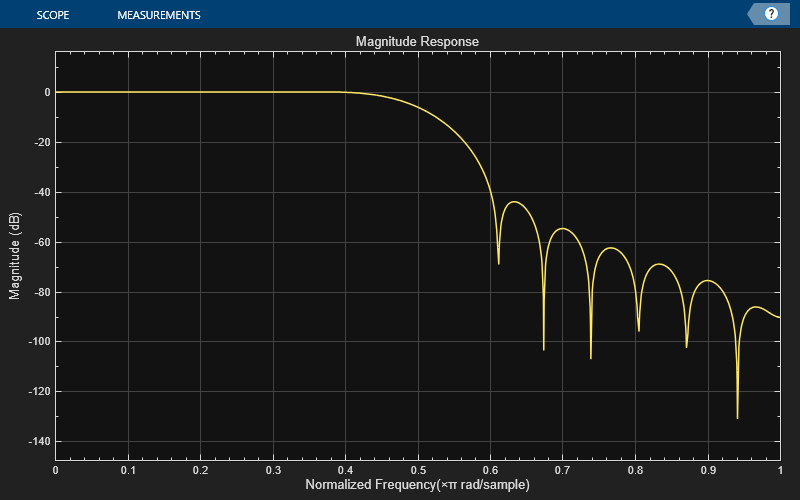
Create a spectrumAnalyzer object to visualize the spectra of the input and output signals.
spectrumScope = spectrumAnalyzer(SampleRate=44100,PlotAsTwoSidedSpectrum=false,... ChannelNames=["Input Signal","Filtered Signal"]);
Stream in random data and filter the signal using the dsp.FIRFilter object. Visualize the spectra of the input and filtered signals using the spectrum analyzer.
for idx = 1:500 x = randn(1024,1); y = firFilt(x); spectrumScope(x,y); end
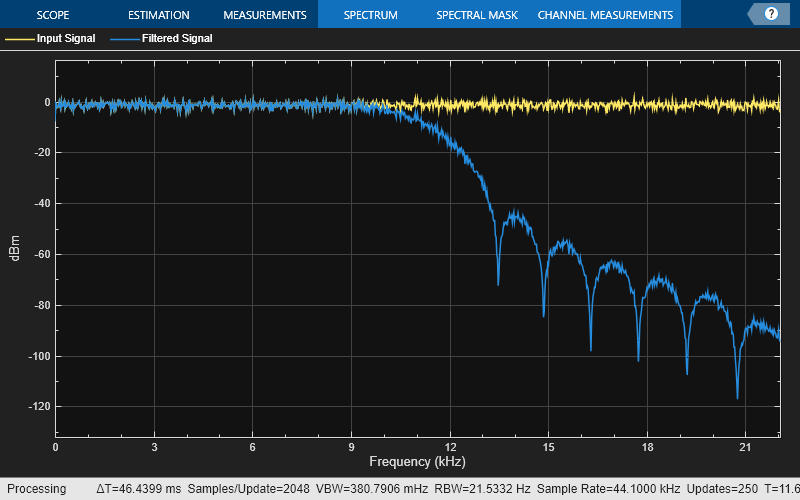
Design an equiripple FIR halfband filter with the order of 24 and a transition width of 0.1 using the designHalfbandFIR function. Assign the filter coefficients to a dsp.FIRFilter System object.
b = designHalfbandFIR(FilterOrder=24,DesignMethod="equiripple");
hbFIR = dsp.FIRFilter(b);Create a dsp.DynamicFilterVisualizer object and visualize the magnitude response of the filter.
dfv = dsp.DynamicFilterVisualizer(NormalizedFrequency=true); dfv(hbFIR);

Create a spectrumAnalyzer object to visualize the spectra of the input and output signals.
scope = spectrumAnalyzer(SampleRate=2, PlotAsTwoSidedSpectrum=false,... ChannelNames=["Input Signal","Filtered Signal"]);
Stream in random data and filter the signal using the FIR halfband filter.
for i = 1:1000 x = randn(1024, 1); y = hbFIR(x); scope(x,y); end
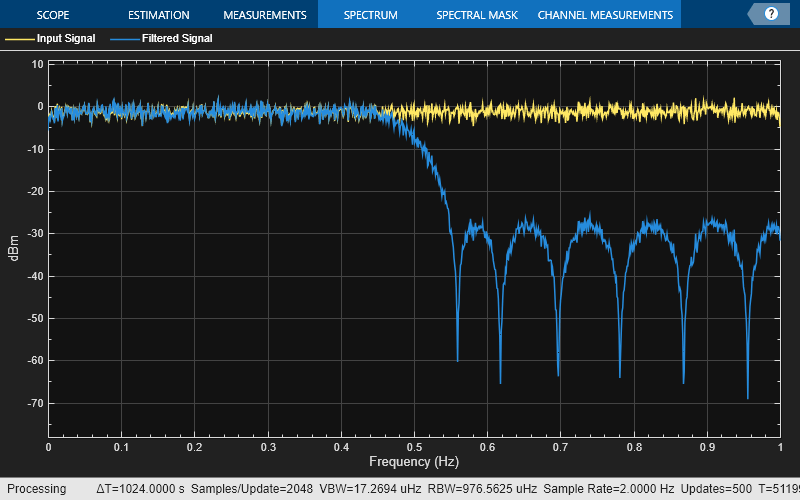
Since R2023b
Design a lowpass FIR filter using the designfilt function.
The filter is a minimum order filter with a passband frequency of 0.45 and a stopband frequency of 0.55 in normalized frequency units. The passband ripple is 1 dB and the stopband attenuation is 60 dB. Use the Kaiser window design method and set the SystemObject argument to true.
With these specifications, the designfilt function generates a dsp.FIRFilter System object™.
lpFIRFilter = designfilt("lowpassfir", ... PassbandFrequency=0.45,StopbandFrequency=0.55, ... PassbandRipple=1,StopbandAttenuation=60, ... DesignMethod="kaiserwin",SystemObject=true)
lpFIRFilter =
dsp.FIRFilter with properties:
Structure: 'Direct form'
NumeratorSource: 'Property'
Numerator: [1.2573e-04 -1.9141e-04 -2.7282e-04 3.7207e-04 4.9141e-04 -6.3325e-04 -8.0016e-04 9.9490e-04 0.0012 -0.0015 -0.0018 0.0021 0.0025 -0.0029 -0.0034 0.0040 0.0046 -0.0053 -0.0060 0.0069 0.0079 -0.0090 -0.0102 0.0116 … ] (1×74 double)
InitialConditions: 0
Show all properties
Visualize the magnitude and phase responses of this filter using freqz.
freqz(lpFIRFilter.Numerator)
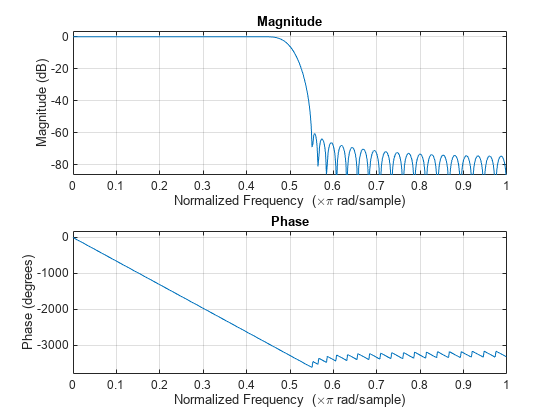
Algorithms
This object implements the algorithm, inputs, and outputs described on the Discrete FIR Filter (Simulink) block reference page. The object properties correspond to the block parameters.
Extended Capabilities
Usage notes and limitations:
Only the
Numeratorproperty is tunable for code generation.See System Objects in MATLAB Code Generation (MATLAB Coder).
The dsp.FIRFilter
System object supports SIMD code generation using Intel® AVX2 code replacement library under these conditions:
Filter structure is set to
"Direct form"or"Direct form transposed".Input signal is real-valued with real filter coefficients.
When the filter structure is set to
"Direct form", the input signal can also be complex-valued with real or complex filter coefficients.Input signal has a data type of
singleordouble.
The SIMD technology significantly improves the performance of the generated code. For more information, see SIMD Code Generation. To generate SIMD code from this object, see Use Intel AVX2 Code Replacement Library to Generate SIMD Code from MATLAB Algorithms.
For workflow and limitations, see HDL Code Generation for System Objects (HDL Coder).
Note
For a hardware-optimized FIR filter algorithm that supports HDL code generation, use
the dsphdl.FIRFilter (DSP HDL Toolbox)
System object. This object has hardware-friendly valid and reset control signals, and
models exact hardware latency behavior. The object supports HDL code generation with
HDL Coder™ tools.
Version History
Introduced in R2012aStarting in R2025a, the Filter Design HDL Coder™ product is discontinued. So, this object no longer supports HDL code
generation by using the generatehdl function. The object still supports
code generation using HDL Coder tools.
The designfilt function generates
a dsp.FIRFilter object when you specify
"lowpassfir" and
"highpassfir" filter responses and set the
SystemObject flag to
true.
lpFIRFilter = designfilt("lowpassfir", ... PassbandFrequency=0.45,StopbandFrequency=0.55, ... PassbandRipple=1,StopbandAttenuation=60, ... DesignMethod="kaiserwin",SystemObject=true)
lpFIRFilter =
dsp.FIRFilter with properties:
Structure: "Direct form"
NumeratorSource: "Property"
Numerator: [1.2573e-04 -1.9141e-04 -2.7282e-04 3.7207e-04 … ] (1×74 double)
InitialConditions: 0The Design
Filter Live Editor task generates a dsp.FIRFilter object
for lowpass FIR and highpass FIR filter responses when you select the Use a System
object to implement filter check box in the task UI and run the
designfilt code the task generates.
See Also
Functions
freqz|filterAnalyzer|impz|info|coeffs|cost|grpdelay|outputDelay|designLowpassFIR|designBandpassFIR|designBandstopFIR|designHighpassFIR|designFracDelayFIR|designHalfbandFIR
Objects
Blocks
- Discrete FIR Filter (Simulink)
MATLAB Command
You clicked a link that corresponds to this MATLAB command:
Run the command by entering it in the MATLAB Command Window. Web browsers do not support MATLAB commands.
选择网站
选择网站以获取翻译的可用内容,以及查看当地活动和优惠。根据您的位置,我们建议您选择:。
您也可以从以下列表中选择网站:
如何获得最佳网站性能
选择中国网站(中文或英文)以获得最佳网站性能。其他 MathWorks 国家/地区网站并未针对您所在位置的访问进行优化。
美洲
- América Latina (Español)
- Canada (English)
- United States (English)
欧洲
- Belgium (English)
- Denmark (English)
- Deutschland (Deutsch)
- España (Español)
- Finland (English)
- France (Français)
- Ireland (English)
- Italia (Italiano)
- Luxembourg (English)
- Netherlands (English)
- Norway (English)
- Österreich (Deutsch)
- Portugal (English)
- Sweden (English)
- Switzerland
- United Kingdom (English)